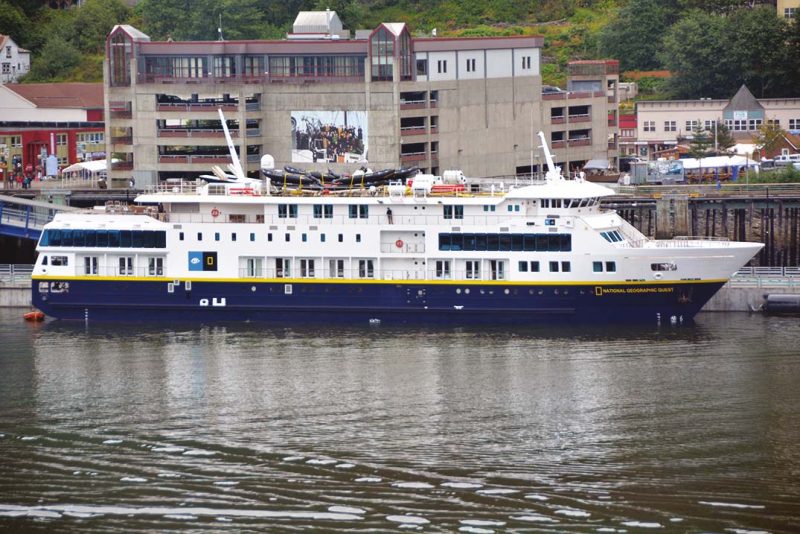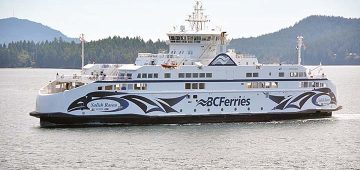NEWBUILD DEBUT AT LAST
On 29th July Lindblad Expeditions’ 2,920gt/2017 built National Geographic Quest, the company’s first newbuild in its history, commenced her inaugural voyage when she set out from Juneau. The most state-of-the-art expedition ship designed and purpose-built in the USA, departed with very excited guests onboard for an 8-day expedition exploring Southeast Alaska. The 100-guest ship operated the popular “Exploring Alaska’s Coastal Wilderness” expedition to 26th August and then concluded the Alaska season with a “Treasures of the Inside Passage – Alaska and British Columbia” departure on 2nd September 2017. The new ship will then remain in the Pacific Northwest for a series of new voyages between Seattle and Vancouver, with calls to the San Juan Islands, Victoria, Alert Bay, and more far reaching stop overs in British Columbia’s channels and fjords. Beginning in December, the National Geographic Quest will reposition and operate expeditions in Costa Rica and Panama before embarking upon a series of new voyages in Belize and Guatemala from February. The vessel’s maiden season was delayed when she was damaged during the launching process on 14th June when the stern section grounded, damaging one propeller and rudder. The incident resulted in the cruises on 8th and 15th July being cancelled. She is seen above at Juneau in August.
ECOSHIP FINALISED
Peace Boat of Japan is planning to build five new ships that go further than the prototype Ecoship by using increased battery power and deploying fuel cell technology. The near sisters to the LNG dual-fuel Ecoship will be constructed subject to market conditions. Arctech Helsinki Shipyard Inc, is to construct the Ecoship, the world’s most sustainable cruise ship. The design for the initial Ecoship was finalised earlier in 2017 and the vessel will be a 60,000gt ocean liner with a passenger capacity of 2,000 and 750 cabins. The ship will be 250m long with a beam of 32m and a draught of 8m. The maximum speed will be 21 knots and with a cruising speed of 17 knots. This overall project is unique in that it signals the first time that the advanced energy technologies on board will be incorporated on a large-scale ship rather than on experimental vessels, as in previous projects. The Ecoship aims to show ship owners and builders around the world that more sustainable vessels are possible.

The Ecoship’s design includes 10 large retractable elements made up of solar panels, which can operate as large sails in suitable wind conditions. For preliminary design of this distinctive feature,
Oliver Design worked with German naval engineer Detlev Loell, who brought his expertise to the project as an internationally renowned expert on classic sailing ships. The sails can be used for both propulsion and power generation. The Ecoship is designed to include a total of 6,000m2 of solar panels with an output of 750 kW. The ship will also have a hybrid engine, capable of being powered by diesel or LNG, saving up to 20% in fuel consumption and reducing carbon emissions by up to 40% compared to a similar ship with conventional technology. The new vessel will also be equipped with all the latest advances in waste disposal and architectural design features based on what is known as the biophilia concept. Biophilia is a building concept that advocates maximum use of natural elements such as air, light and water, as well as materials and designs based on nature itself.
PORTUGUESE EXPLORER
Quark Expeditions is constructing a new expedition ship at the West Sea Shipyard near Porto, Portugal. To be delivered for the 2018-2019 Antarctica season, the World Explorer will be the first in a series of Rolls-Royce-based 176-passenger ships built at that location. Portuguese businessman Mario Ferreria is behind the newbuild, which falls under the Mystic Cruises and Mystic Invest banner and is also owner of Douro Azul, a boutique Portuguese river cruise line that also builds vessels at WestSea, plus Germany’s Nicko Cruises. The World Explorer is the 20th expedition vessel to be ordered since early 2016. The World Explorer will offer expeditionary cruise itineraries in Antarctica from November to March and this new vessel’s inaugural Antarctic season is already fully chartered to, and being distributed globally by, Quark Expeditions. For the rest of the season the ship will visit small ports around the world normally not accessible to larger cruise ships for Nicko Cruises. The ship’s design is the result of several years of study and development to create the perfect balance between luxury, comfort, efficiency and environmentally friendly operation. Rolls- Royce has supplied two Bergen, C25:33L8P main engines and a Bergen C25:33L6P auxiliary dual generator. These connect to a Low Voltage AFE “SAVeCUBE” Power Electric System which allows the engines to operate at variable speeds maximising their efficiency for the required power. Rolls-Royce is also providing the automation and control system, and the complete Promas propulsion system with two CPP propellers integrated with two flap rudders, also steering gears and tunnel thrusters. The 9,300gt World Explorer will be 126m long with a19m beam and 4.8m draught and she was designed by Italian Naval Architect Giuseppe Tringali.

Owned by Adventurer Partners Ltd. and operated by Quark Expeditions, the 4,376gt/1975 built Sea Adventurer has been extensively upgraded at Ulstein Verft with completion in August when she was renamed Ocean Adventurer. All main equipment and engines were replaced, and the accommodation capacity was increased to 132 passengers. The complicated refit included updated and upgraded cabins, remodelled public areas (lounge, dining room & bar) and significant technical upgrades including the installation of new gearboxes, generators and two Rolls Royce engines.






Comments
Sorry, comments are closed for this item